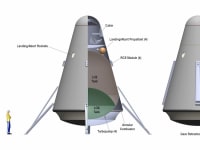- Phoenix Single-Stage-To-Orbit
The Phoenix is a conceptual design for a completely reusable Single Stage to Orbit (SSTO) launch vehicle that can carry small payloads or passengers into low earth orbit (LEO).
The small size and high performance are made possible by innovations in propulsion and design.
- Main Propulsion
The main rocket engine is a plug nozzle (aerospike) concept using annular combustors in a ring around a truncated aerospike. Such an engine automatically adjusts its expansion ratio for maximum performance at any altitude. Properly designed, an aerospike engine can actually be lighter than a bell engine of equivalent thrust. The plug nozzle also doubles as a heat shield surface for re-entry. Exhaust from the turbopumps can be dumped into the base to provide a “virtual spike” to reduce turbulence and drag on launch.
The engine burns LOX/LH2 propellants at higher than normal average mixture ratio and chilled to triple point or lower for higher average density and lower tank weight. This design has four redundant turbopumps.
- Structure
The structure is mostly advanced cryo-compatible composites to maximize mass fraction. Recent advances in this area have made composite launch vehicles more feasible than just a few years ago.
Advanced thermal protection materials are used to shield the structure from launch and reentry heat loads, with active transpirational water cooling for the highest heat loaded areas.
- Landing Propulsion
A separate set of landing rockets, fed by pressurized LOX/LNG propellants, can double as an abort system in an emergency.
- Operations
The vertical take-off and landing configuration allows the use of minimal launch and landing facilities, using relatively inexpensive propellants and a minimum of personnel. The vehicle is small enough that it could be fueled from tanker trucks if necessary.
Total reusability means not dropping rocket parts, so launches from inland areas can be as safe and practical as airline operations.
- Markets
Tourism is one market for this vehicle. Unlike most space touring systems under development, this one is capable of reaching orbit, and has the potential to visit tourist space facilities.
Small science payloads are another use, along with miniature satellites like cubesats.
With a large enough launch support network, point-to-point flights between destinations on Earth become feasible for high-value personnel or cargo. Almost any point on the planet can be reached in less than an hour of flight time.
- Conclusion
The Phoenix-S is a subscale prototype of a well-studied reusable launch concept, at the cutting edge of orbital technology but within the reach of the current art. The concept scales up easily, and larger vehicles would actually have more margin and even larger markets.
- Basic Specifications:
Propellant Weight: 58,400 lbw.
Gross Liftoff Weight: 65,270 lbw.
Injected Weight: 6,870 lbw.
Mass Ratio: 9.5:1
Specific Impulse: 440
Delta Vee: 32K fps
Propellant Mass Fraction: 0.923
Like this entry?
-
About the Entrant
- Name:Tom Brosz
- Type of entry:individual
- Software used for this entry:Solidworks, AutoCAD, Photoshop
- Patent status:none








